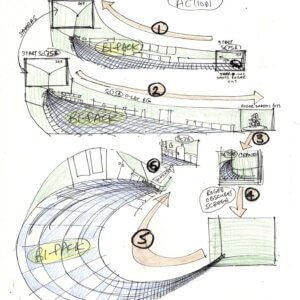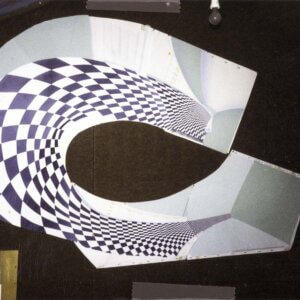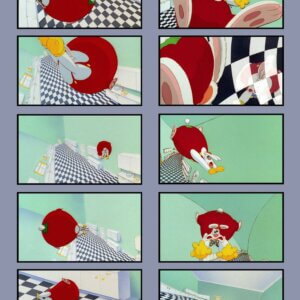Remembering Roy Naisbitt 1930 – 2021
On what would have been the 91st birthday of Roy Naisbitt, friend, collaborator and author of Setting the Scene Fraser MacLean shares his tribute to the legendary layout artist who passed away in April.
I first worked “with” the irreplaceable Roy Naisbitt in 1987/’88 at The Forum in Camden on Who Framed Roger Rabbit but, at the time, he and I never met. Same thing in Acton, way over on the other side of London; Roy and I both worked at the Amblin/Universal studios – but our paths never crossed. In 1995/’96 Roy and I were both working on Space Jam, but even though I was busy with my own tasks in both London and Los Angeles, fate still didn’t bring me into the same space as Roy.
Lord knows, I heard Roy’s name often enough.
Like Dick Williams, whose genius and drive found such a perfect match in Roy, he was an almost mythological figure, even though I knew both men were close at hand and “real”.
No – it wasn’t until a cloudy afternoon in late September 2008 that I found myself outside the front door of the Naisbitt family home in Finchley, nervously pressing the bell. By some weird quirk of fate I’d found myself with a contract from an American publisher to research and write a book about Animation Layout and, one by one, every single Layout Artist I’d approached had given me the same immediate reaction, “I’d be happy to help, but – have you spoken to Roy….?”.

Roy Naisbitt and Steven Spielberg
The message was clear: there could BE no book on Animation Layout if an exploration of Roy’s extraordinary work was not the foundation stone for the whole project.
Not because Roy’s work was in any way “typical”. Far from it. It couldn’t possibly have been less representative of “Layout” as most people in the animation industry practised it. Everyone who had ever had the chance to see any of Roy’s designs, diagrams, plans or mad schemes in action knew there was only one person on God’s green earth who thought, imagined, drew and persevered in this unique way – and with such astonishing results.
To give an example, the first time I had the opportunity to watch Roger Rabbit with a regular cinema audience, I was visiting friends in Vancouver who wanted to see what all the fuss was about. I’d flown to Canada from New York a day or two after the movie’s American premiere at Radio City Music Hall and I’d already had to stop wearing my crew sweat shirt in public because total strangers were following me down the street and asking me questions.
My friends – who were not really animation fans, as such – remained puzzled by all the media attention Roger was getting, and were even more surprised to discover that I’d had anything at all to do with it since my career, up to that point, had been spent working on anything from local news reports to “prestige” live action projects that were a long way from the mainstream – and nothing whatsoever to do with animation.
When we got to the cinema that afternoon it looked, at first, as though there was a fire drill going on. There were SO many people outside the cinema, blocking the suburban traffic and making the kind of noise you usually hear from the crowd outside a rock concert. The young cinema employees were struggling to control everyone. We had reserved tickets but it still took forever to get in and find our seats. My hosts asked the usher how come the cinema, which was ankle-deep in pop corn and discarded paper cups, was such a mess. “Oh, we’ve had to run extra screenings all week to cope with the demand, there’s no time to clean up between shows….”.
Sure enough – AFTER the movie – a high percentage of the audience went BACK to the end of the line, ready to wait another 2 hours to enjoy the whole experience over again.
And what was everyone talking about? Which part of the movie lodged in people’s brains? Somethin’s Cookin, the Maroon Cartoon that introduces us to Roger, Baby Herman and the weird, wonderful world of Toontown.
That was what everyone around us was talking about.
I had seen the movie already, of course, but only with the Cast & Crew at the premiere – in an iconic venue that held an audience of 6,000 people. The more intimate setting of this tiny cinema gave me the chance to turn around and watch the audience watching the movie – and I will never forget seeing the “Mexican wave” rippling through the auditorium as people rose slightly from their seats, “flying” through the air WITH the balloon version of Roger Rabbit as he deflated, zipped and swerved madly around Roy’s amazing cartoon kitchen.
Today I am still using this one pivotal scene to open every class, workshop or presentation I’m asked to give about the history, development and importance of Animation Layout. And I get the same reaction every time – people simply cannot grasp how that “camera move” was possible in the years before the magical x-, y- and z-axis digital environment within which most animators now work – with a weightless, wholly imaginary “camera”.
Back then – when people talked about a “camera move” in Animation, it was entirely misleading because, of course, the last thing a traditional rostrum camera can do – is move. The damn thing is bolted to a steel tower over a fixed compound table. The only movement it can make is to approach the artwork, to get further away from it – or, in some cases, to rotate about the centre of the lens.
But a traditional rostrum camera (as operated, in the case of Roger Rabbit by the equally inimitable and inexhaustible John Leatherbarrow) cannot rotate, tumble or fall. Which means (and this is where you REALLY have to take a deep breath and hope your brain can stretch to accommodate the facts) that Roy – and every other Layout Artist working in the pre-digital era, effectively had, not only to imagine and plan these “moves”, he then had to REVERSE ENGINEER every single one and create frame-by-frame Exposure Sheet instructions for the camera operator to follow.
If you look at the original BG painting for that scene, it’s in the form of a giant horse shoe.
- Who Framed Roger Rabbit (Image Courtesy of Fraser MacLean)
- Who Framed Roger Rabbit (Image Courtesy of Fraser MacLean)
- Who Framed Roger Rabbit (Image Courtesy of Fraser MacLean)
Who knew?
Roy.
Roy knew. And ONLY Roy knew.
I swear – we won’t see his like again. He had the ability not only to be artistically daring but to back up the craziest idea with the most exhaustive planning, plotting and measuring. Inside Roy’s head there was a whole Universe of possibilities – and film-makers from Stanley Kubrick to Robert Zemeckis discovered, along the way, that Roy himself could not only imagine and describe these wonderful illusions, he could make them real. He could make them happen.
He, and he alone, knew how to get all of that magic OUT of his head and onto the screen.
So – when Roy opened the door to me on that September afternoon – I was expecting Merlin.
And Merlin is exactly the character who welcomed me. Not Milt Kahl’s Merlin – but a wonderful, smiling, mischievous, North London suburban Merlin.

Roy Naisbitt in his Attic Room (Image Courtesy of Fraser MacLean)
Merlin’s – sorry Roy’s – wife, Lyn welcomed me too and set about preparing dinner for us while Roy guided me up through the house itself, into a spare bedroom from which a tiny narrow steep staircase led to “the topmost room in the castle” – Roy’s amazing attic studio.
This man was clearly a walking definition of the word “eccentric”: a living, breathing magician with a self deprecating sense of humour and a warm generosity of spirit, ready to wrap its arms around everyone who was lucky enough to come into his orbit.
Again and again, since the news of Roy’s death broke (and broke hearts) last weekend, people have remarked how they felt Roy had taken them “under his wing”. On that first day, talking about my “ideas” for the book on Layout, Roy had been patience personified. He’d prepared 6 carefully hand-written pages of notes, itemising and explaining the flaws and misconceptions in the original book proposal I had sent to him – and he proceeded, one at a time, to read each page out loud to me.
It was a little bit like having Moses go through the 10 Commandments, reading from a school jotter.
Three years later Roy, Scott Caple and Neil Boyle all kindly joined me at the Bradford Animation Festival for the launch of what eventually became “Setting The Scene: The Art & Evolution of Animation Layout”. Again and again during the presentation there were gasps from the audience as I projected slides onto the enormous screen in the Pictureville cinema, showing Scott’s breath-taking architectural perspective of Notre Dame Cathedral and Roy’s staggeringly detailed design for the Golden City in Dick’s Thief & The Cobbler.
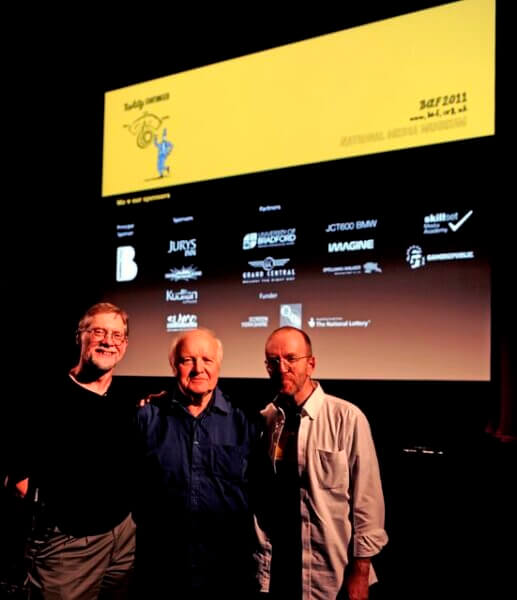
L-R Scott Caple, Roy Naisbitt and Fraser MacLean at BAF 2011 (Image Courtesy of Fraser MacLean)
But the real cherry on the icing was a screening, not long after the UK premiere, of Neil’s The Last Belle which includes a truly mind-bending sequence that Roy not only designed – it could be argued that he had LIVED much of what happens to the character on the screen (but you’d have to get Neil to explain all that to you some other time…). The best I can do here is to note, entirely without judgement, that Roy enjoyed a drink – and was famous for being able to drink more (and for longer) than many people a third of his age. When you watch the sequence in question (the film is freely available on YouTube) bear in mind that Roy himself once fell – delightfully drunk – down the stairs into a London Tube station, just as the hapless lead character does.
However – instead of remembering or dwelling on the aches and pains he suffered – Roy held on instead to the experience and turned it, years later, into the genuinely hilarious “rubberised” world of twisting corridors, melting checkerboard tiled floors and walls and joke posters for imaginary products and venues that we see in this vertigo-inducing sequence.
Like so much of Roy’s work – unless you’re lucky enough ever to see the artwork in its original form, laid out on a table in front of you (and Roy loved nothing better, in the years when he and I were “touring” the book, than to lay open his own career portfolios for all to see….), it’s unlikely your brain will be able to keep up with the speed of the camera moves which, of course, are not “camera moves” at all – but FURTHER figments of Roy’s other-worldly imagination. There are more funny, inventive details in each frame than most of us could ever make out, even with a personal guide and a magnifying glass to help us.

The War Machine
(Image Courtesy of Fraser MacLean)
When Roy showed me his original design sketches for the “War Machine” sequence in The Thief, his face lit up as he drew to my attention the fact that almost every bit of siege machinery had been based on a different kitchen implement – everything from spatulas to cheese graters.
Young festival and campus crowds lit up when Roy was there. Like a rock star they would follow him (always to the bar…) and fix their own attention on his artwork as he leafed through everything he had saved from The Pink Panther to 2001: A Space Odyssey, from Roger Rabbit to The Last Belle. But Roy never played up to that rock star status; instead he was Uncle Merlin to everyone – that particular blend of magic and bonhomie that those of us who had the great good fortune to spend any time in his wonderful company are going to miss so much.
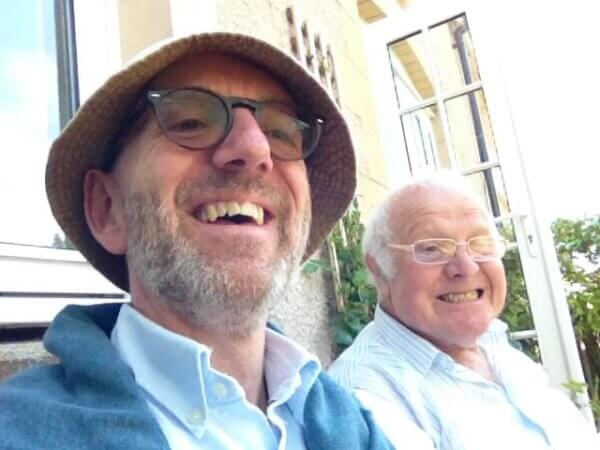
Fraser and Roy (Image Courtesy of Fraser MacLean)
There are, of course, countless other stories and anecdotes that could be shared about Roy. Like so many other people I have struggled, since being told of his passing last week, to put together anything like an adequate social media tribute to him. I think the best way to celebrate Roy’s life, work and spirit would be to throw the biggest pub party ever – and invite everyone who ever knew him.
But, of course, we have the wealth of movie material that Roy has left behind: world-famous movies by internationally recognised Directors, touched, blessed and illuminated by Roy’s super-human imagination.
I’m going to miss him very much. But, oh my…. do I ever feel lucky to have known him – and to have spent even a little time under his wing.
Roy Naisbitt 1930 – 2021



